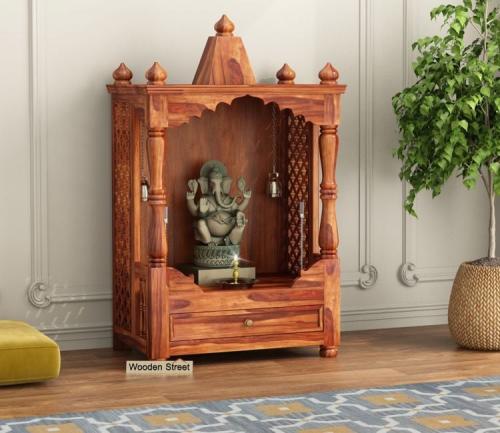Home Temple Showcase: Traditional vs. Contemporary Designs

Creating a home temple is a deeply personal and spiritual journey, and the design of the temple plays a significant role in reflecting one's beliefs and aesthetics. Let's explore the characteristics of traditional and contemporary home temple designs to help you choose the style that resonates with your preferences:

Traditional Home Temple Designs:
Intricate Carvings and Detailing:
Traditional home temples are often characterized by intricate carvings and detailed craftsmanship. Wooden altars may feature ornate patterns, deity motifs, and traditional designs that showcase the rich cultural heritage.
Rich Wooden Finishes:
Wood, especially dark and rich finishes like teak or rosewood, is a hallmark of traditional home temple designs. The warmth of wooden surfaces adds a timeless and classic appeal to the sacred space.
Idol Placement and Alignment:
Traditional designs focus on placing idols and deities at the center of the altar. The arrangement is often symmetrical, with the main deity taking a prominent position, flanked by smaller idols or sacred items.
Incorporation of Sacred Symbols:
Traditional home temples frequently integrate sacred symbols and yantras. These symbols, often associated with specific deities or spiritual concepts, contribute to the overall sanctity of the space.
Emphasis on Ritual Elements:
Traditional designs prioritize the inclusion of ritual elements such as diya (lamp), incense holder, bell, and offering plates. These elements are essential for daily rituals and contribute to the religious ambiance.
Rich Fabrics and Decor:
The use of rich fabrics, such as silk or brocade, is common in traditional home temple designs. These fabrics may be used for altar cloths, drapes, or cushions, adding a touch of opulence.

Contemporary Home Temple Designs:
Sleek and Minimalistic:
Contemporary home temple designs lean towards a sleek and minimalistic aesthetic. Clean lines, simple shapes, and uncluttered surfaces characterize the modern approach, offering a sense of simplicity and sophistication.
Use of Diverse Materials:
Unlike the exclusive use of wood in traditional designs, contemporary home temples embrace a variety of materials. Glass, metal, acrylic, and even composite materials are commonly used, allowing for a fusion of modern elements.
Focus on Functionality:
Contemporary designs often prioritize functionality and practicality. The placement of shelves, storage compartments, and built-in lighting solutions caters to the convenience of daily rituals and storage of sacred items.
Neutral Color Palettes:
Neutral color palettes, including whites, grays, and muted tones, are prevalent in contemporary home temple designs. These colors create a serene and calming atmosphere, promoting a sense of introspection.

Geometric Shapes and Symmetry:
Contemporary designs may feature geometric shapes and symmetrical arrangements. Clean and well-defined lines contribute to a sense of order and modernity within the sacred space.
Integration of Technology:
In contemporary home temple designs, the integration of technology is not uncommon. Built-in speakers for devotional music, smart lighting solutions, or digital screens displaying sacred texts are examples of modern additions.
Choosing the Right Design:
When selecting between traditional and contemporary home temple designs, consider your personal preferences, the existing decor of your home, and the spiritual ambiance you wish to create. Whether you opt for the timeless elegance of traditional designs or the sleek modernity of contemporary styles, the key is to create a sacred space that resonates with your spiritual journey and enhances the overall atmosphere of your home.
Advertise on APSense
This advertising space is available.
Post Your Ad Here
Post Your Ad Here
Comments